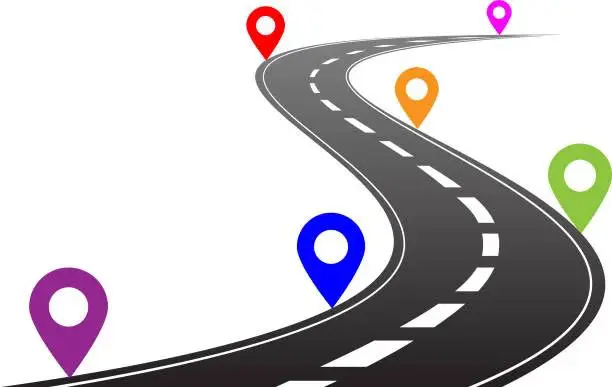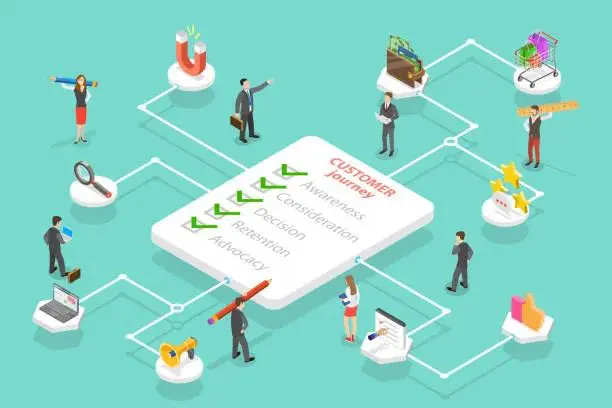Imagine you are going away for a weekend road trip. You have no direction of where you are heading. You aimlessly drive on the streets while wasting a ton of gas but cannot get anywhere near your destination. Well, that is because you did not have a road map to the location.
A product roadmap also works in a similar way. The only difference is that in a product roadmap your main focus is not just the car you are driving but all the other vehicles driving on the road and the landscape that keeps on changing from time to time.
In this guide, we will take you through what a product is and how you can create an effective one.
Why Should You Create a Product Roadmap?
Creating a roadmap comes with a lot of benefits. One of its main benefits is the strategic vision it shows to all the stakeholders. The roadmap matches the company goals and broader product with efforts in development, which positions the teams around the general purposes of creating great products.
- For product managers and owners, roadmaps unite the teams working on high-impact product enhancements and let them talk about priorities effectively with adjacent teams.
- For the developers, roadmaps help you understand the big picture in a better way, which lets the team members focus on the essential tasks, make fast and autonomous decisions, and avoid scope creep.
- For organizational leadership, the roadmap gives you work updates and translates the developers’ tasks in Jira into non-technical words and an easy-to-understand format.
Read More About: Best Practices of UX Design
How to Prepare for Product Roadmaps Development?
In order to build product roadmaps, you first need to have a product vision that is clear and straightforward. Once you have that in hand, you can now proceed to prepare for the product roadmap development. This preparation will help you create more effective product roadmaps.
1- Do Market Research
If you are an existing business then you might not need to implement that step in-depth since you will already have an idea of what the market demands and so you can make better predictions and create your product roadmaps around it.
But if you are just starting out then you might have to face some trouble since new products are being launched every day and there is a chance that some other business might launch a solution better than what you are working on.
This is why market research is important. You need to understand the roots of your target market and then determine what you should create and how quickly you should create it.
READ MORE: Everything about software development team structure
2- Determine Your Product Value
Once you are done with the market research, you will already have an idea of the problem the customers are facing. They won’t turn towards your solution just because it is available in the market. They will turn towards it only if it provides something others don’t.
Before creating a product roadmap, you should settle upon the value your product is bringing and decide why the users would choose your website or application over your competitors.
3- Set Goals
Setting goals is really important in order to create a good product roadmap because then you will know where you are heading to.
While setting goals, be as specific as you can. Gauge down to the main point such as the net revenue or the app store rating. You may also set a time limit in which you want to achieve that goal for example you want to generate $350 in revenue from your app in the first month.
4- Detect the Obstacles
The path to a successful product is not always smooth. There are a lot of things you will have to consider. While preparing for the product roadmap make sure to highlight what obstacles might come in your way. Is the time too short or are you lacking some tech?
Keep these obstacles in view so they do not get ignored. In the event that you don’t do as such, be prepared to meet some serious issues and challenges ahead.
Read More About: What is the mean difference in Cloud VS Saas?
How to Create a Product Roadmap?
Now that you are aware of your goals and constraints. It’s time to get down to the actual product roadmap. Here are 5 steps to building an effective product roadmap.

1- Choose Your Focus
A product roadmap in simple words is a timeline of your project. It shows how your product progresses. It is up to you to decide what demonstrates progress for you.
Is it when you finish a certain task in its allotted time or when you achieve a certain goal. Choosing your focus of the timeline is the initial step of creating a product roadmap. Usually, there are 2 types of product roadmap:
Feature-based Roadmap: This is the type of roadmap where your progress is defined by the release of the features. It is mostly used in IT-based organizations.
Goal-based Roadmap: In a goal-based roadmap, progress is identified by achievement goals for e.g enabling the application for sign-in.
READ MORE: How is Webflow different from WordPress?
2- Master Prioritization
The following significant thing is to pick basic objectives and focus on them.
Waitlist your principal objectives and conclude which ought to be put on your roadmap first. Attempt a cost-benefit analysis to zero in on the most valuable objectives and devices. Contrast the work you want to achieve a specific objective to the effect this objective will have on the whole item.
To prioritize the features, you may ask yourself the following questions:
- What advantages do I anticipate that the item should give?
- Are there any dangers if I don’t add this element?
There’s no compelling reason to pack your fourteen-day runs with many elements and expect your developers team to deliver them all.
Utilize an iterative methodology and add huge elements individually. In the interim, measure their effect on the final product. There might be sufficient opportunities to improve your item and add more components to it.
In any case, if you neglect to focus on elements and start delivering features your user needn’t bother with, you might lose their consideration and need to start from the very beginning once more.
3- Determine Your Resources.
Examine the time and the budget available to you. Contemplate the group you can work with.
Time and Window of Opportunity.
What is your open-door opportunity? How long do you need to give your clients a specific component before another organization does likewise?
The right timing is everything. In the event that you can plainly see there’s rising interest on the lookout, don’t squander a subsequent more and begin searching for ways of fulfilling this interest.
Examine how long you need to set sensible cutoff times.
Budget and Rough Development Quote
Imagine you are planning a weekend getaway with a restricted budget. While doing as such, you attempt to improve assets to take advantage of the cash accessible. You check Google Maps for streets without any parking charges, look for reasonable Airbnb stays, search your email for gas promotion codes or other extraordinary offers, search for modest voyaging tips, etc.
Fostering a product roadmap likewise assists you with upgrading costs. It assists you with fostering the main usability first, changing your needs in the event that you can’t demonstrate your suspicions, or turning and beginning fostering an alternate item.
Notwithstanding, you ought to understand what your financial plan is before you plunge into MVP development points of interest.
A rough gauge isn’t enough for a successful turn of events. Utilize this methodology for making yes/no choices:
- Say OK and go for item improvement assuming the good guess matches your financial plan.
- Say no, change your startup item guide, or change the whole item procedure assuming the gauge is a lot higher than your accessible financial plan.
Development Team Size and Composition
What number of experts do you work with? Does your group have sufficient ability to send off focused on the usefulness on time and fit inside runs? Converse with your designing group and attempt to settle on the vision for the advancement interaction.
Increase your development team with new specialists to ensure your ability is adequate.
Converse with your product improvement accomplices and increment a group quickly to stay away from inconveniences from now on.
4- Understand the Dependencies
To create your roadmap accurately, you really want to comprehend what your deliveries might rely upon. There are three principal prospects:
Deliveries Relying Upon Each Other
The finish of the main delivery is at the beginning of the second. Other than every one of the errors made in the past delivery, upgrades and bug fix additionally influence the following delivery.
Remember this while focusing on your objectives and making arrangements for highlights for each delivery.
Deliveries Relying Upon Individuals
A programmer can’t contribute over 40 hours of the week and 80 hours for each run in your item. Regardless of how hard you need to execute complex usefulness in the run, the improvement group may basically not have sufficient ability to product manage the undertakings without a product manager.
Accordingly, you want to include your product manager group in time gauges and let them set sensible cutoff times for every specialized undertaking.
Deliveries Relying Upon Different Items
The outer APIs, modules, cloud administrations, and SaaS arrangements you use likewise influence your deliveries.
It might require a lot of work to interface your application to a specific help, and you ought to consider this.
Read More About: How is an application developer different from a software developer?
5- Make Your Guide Quantifiable
How would you characterize the outcome of each delivery? How might you ensure you’ve made the right strides?
Use information-driven examination to guarantee the item’s prosperity. Figure out what to quantify and define quantifiable objectives.
Depict every objective you set for the ongoing delivery. State what quantitative measure would demonstrate its prosperity. Set a deadline for finishing every objective or delivering each element and return to these dates during the run survey.
READ MORE: How to Make An Uber-Like App?
How to Visualize Your Product Roadmap?
Now when we have talked enough about creating a roadmap. Let’s also discuss how you can visualize your roadmap. Luckily there are some of our favorite project management tools that let you organize your ideas, plans, assignments, and deadlines in one place.

1- Spreadsheet.
If you are a startup then using a spreadsheet would be the most convenient choice for you as it does not include any rocket fast science or demands you to be a tech expert. Google Sheets and Microsoft Excel are the two easiest software you can use to visualize your roadmap.
2- StoryBoard.
A storyboard is a perfect choice to visualize your roadmap into an engaging and visually appealing one. You can share this with external users or clients and win their approval even before the product is developed.
The best software to create a storyboard roadmap is Canva. It has a wide collection of ready-made product roadmap templates and a lot of customization options as well.
3- Jira.
If you are an existing business and looking for a reliable project management tool to visualize your product roadmaps then Jira is the way to go. It is regarded as the best project management tool for product roadmap by many companies. You can easily integrate your roadmap on Jira and link it to other work related documents.
Read More About: How Much Does Fractional CTO Cost?
Product Roadmap Examples
There are many different ways to create your product roadmap. The best for you depends on the nature of your product and company. While some businesses use roadmaps to keep track of their feature releases, some use them to manage their entire product lineup development.
Here are the three most common examples of Product Roadmaps:
Single Product Roadmap
If you are handling one product at a time then the single product roadmap might be the best for you.
This is an essential, high-level report which you won’t just form to show to your chiefs, procure their up-front investment, and afterward hold it while you continue ahead with the genuine work of driving the item’s turn of events.
This product roadmap will be one of your essential, progressing instruments for driving that turn of events. It ought to be educated regarding what you are doing for all intents and purposes consistently.
Multiple Product Roadmap
This roadmap consolidates a few items and has the additional advantage of permitting you to make a drawn-out essential perspective on your item’s process in the bigger setting of the synchronous improvement of different products.
You could keep a few single-product roadmaps, one for every item you are liable for. Be that as it may, this would make a ton of copy work, compelling you to track and audit more reports and deny you and your capacity to see every item with the same diligence.
Agile Product Roadmap
While your single and multiple product roadmaps intermittently are centered around imparting your procedure to leader partners, you will utilize your agile roadmap principally with your development group.
Despite the fact that it is centered essentially around momentary subtleties, the agile roadmap should in any case introduce an essential view — connecting together the divergent highlights and stories in a run to show how every one of these singular undertakings is pursuing a binding together goal. This is significant in light of the fact that your designers need to grasp the item’s generally vital direction towards a unifying objective.
Read More About: The Comprehensive Guide to Startup CTO
What Is An Agile Roadmap?
An Agile Product Roadmap is a product strategy of how a result of arrangement will develop over the long haul.
Agile Roadmaps are portrayed by brief periods of time, regular acclimations to take into consideration alterable component gauges and constant programming testing, and permit groups to look past the following significant delivery unhesitatingly.
Agile roadmaps focus on reflecting item procedure yet in addition to answering changes, for example, changes in the cutthroat scene, offers, and design requirements.
Hapy is a team of creative people that solves challenges regarding Designing and Development. It has a team of Product Designers and Webflow Developers. You can contact them if you’re looking for a Product Designer or Webflow and MVP developer.
Agile Roadmap resources empower agile teams to keep track of their achievements, elements, and item technique to settle on better-informed choices and focus on their errands.
Non-agile product roadmaps are characterized by highlights and courses of events, whereas agile product roadmaps example is aimed at product improvement, focusing on demanded objectives and results and giving essential setting to a product group’s everyday errands. Sometimes multiple agile internal teams might share a solitary agile roadmap.
Final Words
Creating an effective roadmap is a long process and you might have to keep on changing and updating things along the way. However, having a reliable guide by your side would make the task a lot easier. We hope this guide helps in clearing your confusion regarding creating a product roadmap. Do contact us for Webflow and MVP Development.
Thanks for reading!
FAQs
How Long Does It Take To Create a Product Roadmap?
If you have everything prepared in advance and have a professional development team by your side then it won’t take any longer than 4 to 6 hours.
What Should Be Included in a Product Roadmap?
An effective roadmap includes a vision, a product strategy, and a final goal.
How Long Does It Take To Create a Product Roadmap?
If you have everything prepared in advance and have a professional development team by your side then it won’t take any longer than 4 to 6 hours.
What Should Be Included in a Product Roadmap?
An effective roadmap includes a vision, a product strategy, and a final goal.




